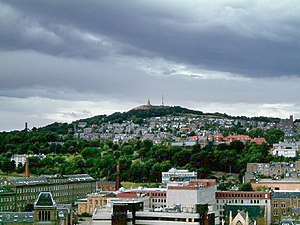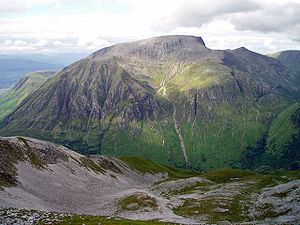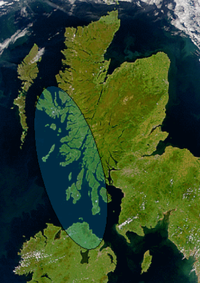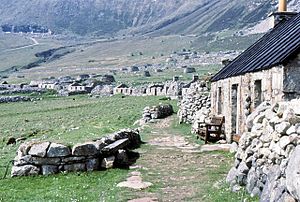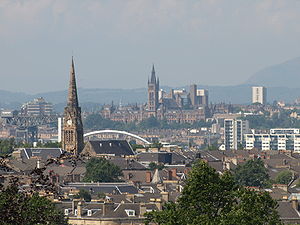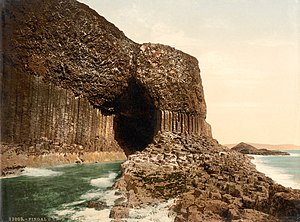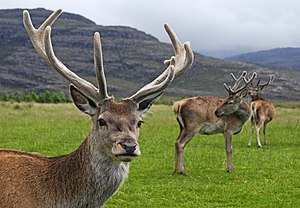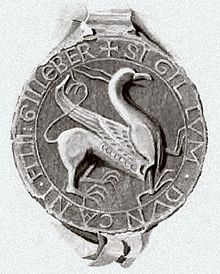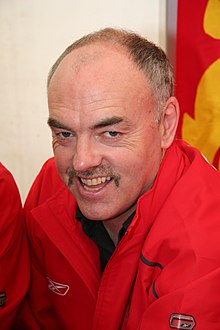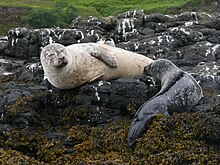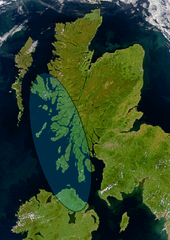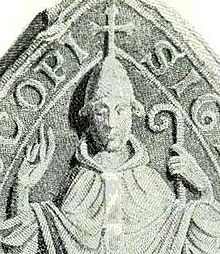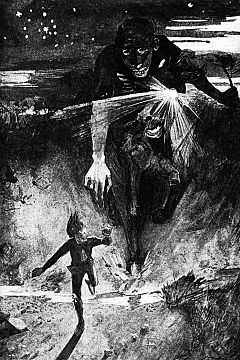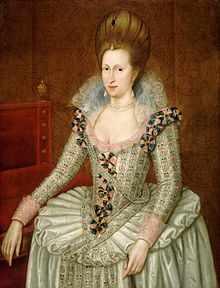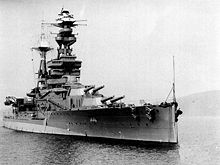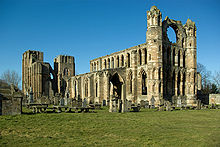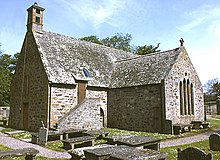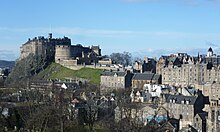User:Cactus.man/Sandbox/P-Sco/Selected articles
The Scotland Portal
| Main Page | Selected articles | Selected biographies | Selected quotes | Selected pictures | Featured Content | Categories & Topics |
Hand picked articles 1
Hand picked articles 2
Featured articles
Featured articles

Hillforts in Scotland are earthworks, sometimes with wooden or stone enclosures, built on higher ground, which usually include a significant settlement, built within the modern boundaries of Scotland. They were first studied in the eighteenth century and the first serious field research was undertaken in the nineteenth century. In the twentieth century there were large numbers of archaeological investigations of specific sites, with an emphasis on establishing a chronology of the forts. Forts have been classified by type and their military and ritual functions have been debated.
They were introduced into Scotland during the Bronze Age from around 1000 BCE. The largest group are from the Iron Age, with over 1,000 hillforts, mostly below the Clyde-Forth line, most of which were abandoned during the period of Roman occupation of Britain. There are also large numbers of vitrified forts, which have been subjected to fire, many of which may date to this period and are found across Scotland. After Roman occupation in the early Middle Ages some hillforts were reoccupied and petty kingdoms were often ruled from smaller nucleated forts using defensible natural features, as at Edinburgh and Dunbarton. (Full article...)
}
'"`UNIQ--templatestyles-00000090-QINU`"'
'"`UNIQ--references-00000091-QINU`"'
Source: (Full article...)
'"`UNIQ--templatestyles-00000090-QINU`"'
'"`UNIQ--references-00000091-QINU`"'
Source: (Full article...)

The mountains and hills of the British Isles are categorised into various lists based on different combinations of elevation, prominence, and other criteria such as isolation. These lists are used for peak bagging, whereby hillwalkers attempt to reach all the summits on a given list, the oldest being the 282 Munros in Scotland, created in 1891.
A height above 2,000 ft, or more latterly 610 m, is considered necessary to be classified as a mountain – as opposed to a hill – in the British Isles. With the exception of Munros, all the lists require a prominence above 15 metres (49.21 ft). A prominence of between 15 and 30 metres (49.21 and 98.43 ft) (e.g. some Nuttalls and Vandeleur-Lynams), does not meet the International Climbing and Mountaineering Federation (UIAA) definition of an "independent peak", which is a threshold over 30 metres (98 ft). Most lists consider a prominence between 30 and 150 metres (98.43 and 492.1 ft) as a "top" (e.g. many Hewitts and Simms). Marilyns, meanwhile, have a prominence above 150 metres (492.1 ft), with no additional height threshold. They range from small 150-metre (490 ft) hills to the largest mountains. Prominences above 600 metres (1,969 ft), meet the P600 (the "Majors") classification, which is the UIAA international classification of a "major" mountain. (Full article...)
Giffnock (/ˈɡɪfnək/; Scots: Giffnock; Scottish Gaelic: Giofnag, pronounced [ˈkʲifnak]) is a town and the administrative centre of East Renfrewshire in the Central Lowlands of Scotland.
It lies 3.7 miles (6.0 km) east of Barrhead, 5.6 miles (9.0 km) east-southeast of Paisley and 5.3 miles (8.5 km) northwest of East Kilbride, at the southwest of the Greater Glasgow conurbation. (Full article...)
Edinburgh Zoo (Scottish Gaelic: Sù Dhùn Èideann), formerly the Scottish National Zoological Park, is an 82-acre (33 ha) non-profit zoological park in the Corstorphine area of Edinburgh, Scotland.
The zoo is positioned on the south-facing slopes of Corstorphine Hill, giving extensive views of the city. Established in 1913, and owned by the Royal Zoological Society of Scotland, it receives over 600,000 visitors a year, which makes it one of Scotland's most popular paid-for tourist attractions. As well as catering for tourists and locals, the zoo is involved in many scientific pursuits, such as captive breeding of endangered animals, researching into animal behaviour, and active participation in various conservation programmes around the world. (Full article...)
The zoo is positioned on the south-facing slopes of Corstorphine Hill, giving extensive views of the city. Established in 1913, and owned by the Royal Zoological Society of Scotland, it receives over 600,000 visitors a year, which makes it one of Scotland's most popular paid-for tourist attractions. As well as catering for tourists and locals, the zoo is involved in many scientific pursuits, such as captive breeding of endangered animals, researching into animal behaviour, and active participation in various conservation programmes around the world. (Full article...)
Aberdeen Football Club is a Scottish professional football club based in Aberdeen, Scotland. They compete in the Scottish Premiership and have never been relegated from the top division of the Scottish football league system since they were elected to the top flight in 1905. Aberdeen have won four Scottish league titles, seven Scottish Cups and six Scottish League Cups. They are also the only Scottish team to have won two European trophies, having won the European Cup Winners' Cup and the European Super Cup in 1983.
Formed in 1903 as a result of the amalgamation of three clubs from Aberdeen, they rarely challenged for honours until the post war decade, when they won each of the major Scottish trophies under manager Dave Halliday. This level of success was surpassed in the 1980s, when, under the management of Alex Ferguson, they won three league titles, four Scottish Cups and a Scottish League Cup, alongside the two European trophies. Aberdeen were the last club outside the Old Firm to win a league title, in 1984–85, and also the last Scottish team to win a European trophy. The team has enjoyed less success since this golden era, though a 19-year wait for a major trophy was ended by winning the 2013–14 Scottish League Cup, followed up by multiple second-place finishes behind Celtic in the league during the 2010s. (Full article...)
Formed in 1903 as a result of the amalgamation of three clubs from Aberdeen, they rarely challenged for honours until the post war decade, when they won each of the major Scottish trophies under manager Dave Halliday. This level of success was surpassed in the 1980s, when, under the management of Alex Ferguson, they won three league titles, four Scottish Cups and a Scottish League Cup, alongside the two European trophies. Aberdeen were the last club outside the Old Firm to win a league title, in 1984–85, and also the last Scottish team to win a European trophy. The team has enjoyed less success since this golden era, though a 19-year wait for a major trophy was ended by winning the 2013–14 Scottish League Cup, followed up by multiple second-place finishes behind Celtic in the league during the 2010s. (Full article...)
Andrew Stuart Murray McCall (born 10 June 1964) is a professional football coach and former player. He was most recently assistant manager at Sheffield United.
McCall played in a total of 763 league games and in 40 full international matches for Scotland during his playing career. (Full article...)
The 2001 Scottish Masters (known as the 2001 Regal Scottish Masters for sponsorship reasons) was a professional non-ranking snooker tournament which took place at the Thistle Hotel in Glasgow, Scotland, from 18 to 23 September 2001. It was the first time the tournament was played in Glasgow since the 1989 edition. The competition was the second of four invitational World Professional Billiards and Snooker Association (WPBSA) events of the 2001–02 season. It was broadcast on BBC Scotland and Eurosport and was sponsored by the cigarette brand Regal.
John Higgins, the top-ranked Scottish player, won the tournament, defeating the defending champion and world title holder Ronnie O'Sullivan 9–6 in the final. It was the first time that Higgins had won the competition it was the 22nd ranking tournament victory of his career. He earned £63,000 from a prize fund pool of £200,000. O'Sullivan made the highest break of the competition of 134 in his semi-final victory over Marco Fu. (Full article...)
John Higgins, the top-ranked Scottish player, won the tournament, defeating the defending champion and world title holder Ronnie O'Sullivan 9–6 in the final. It was the first time that Higgins had won the competition it was the 22nd ranking tournament victory of his career. He earned £63,000 from a prize fund pool of £200,000. O'Sullivan made the highest break of the competition of 134 in his semi-final victory over Marco Fu. (Full article...)

The role of a Scotland national football team manager was first established in May 1954, when Andy Beattie was appointed. Beattie took charge of six matches before and during the 1954 FIFA World Cup, when Scotland competed at their first major tournament. Twenty-four men have occupied the post since its inception, with Beattie, Jock Stein and Alex McLeish occupying it in two spells. Six of those managers were in caretaker or interim roles. Craig Brown held the position for the longest to date; a tenure of 9 years, comprising two major tournaments and a total of 71 matches.
No manager has progressed beyond the first group stage of a major competition, even though Scotland qualified for several between 1954 and 1998. Beattie (1954), Dawson Walker (1958), Willie Ormond (1974), Ally MacLeod (1978), Stein (1982), Alex Ferguson (1986), Andy Roxburgh (1990 and 1992), Brown (1996 and 1998) and Steve Clarke (2020) have all managed the team at major competitions. Ian McColl, Ormond and MacLeod all won the British Home Championship outright. (Full article...)
}
'"`UNIQ--templatestyles-00000057-QINU`"'
'"`UNIQ--references-00000058-QINU`"'
Source: (Full article...)
'"`UNIQ--templatestyles-00000057-QINU`"'
'"`UNIQ--references-00000058-QINU`"'
Source: (Full article...)
Hibernian Football Club (/hɪˈbɜːrniən/), commonly known as Hibs, is a professional football club in Edinburgh, Scotland. The team competes in the Scottish Premiership, the top division of Scottish football. The club was founded in 1875 by members of Edinburgh's Irish community, and the name is derived from the Latin for Ireland. The Irish heritage of Hibernian is still reflected in the name, colours and badge of the club. Their local rivals are Heart of Midlothian, with whom they contest the Edinburgh derby.
Home matches are played at Easter Road, which has been in use since 1893, when the club joined the Scottish Football League. The name of the club is regularly shortened to Hibs, with the team also being known as The Hibees (pronounced /ˈhaɪbiːz/) and supporters known as Hibbies. Another nickname is The Cabbage, derived from the shortened rhyming slang for Hibs ("Cabbage and Ribs"). (Full article...)
Home matches are played at Easter Road, which has been in use since 1893, when the club joined the Scottish Football League. The name of the club is regularly shortened to Hibs, with the team also being known as The Hibees (pronounced /ˈhaɪbiːz/) and supporters known as Hibbies. Another nickname is The Cabbage, derived from the shortened rhyming slang for Hibs ("Cabbage and Ribs"). (Full article...)
The Renaissance in Scotland was a cultural, intellectual and artistic movement in Scotland, from the late fifteenth century to the beginning of the seventeenth century. It is associated with the pan-European Renaissance that is usually regarded as beginning in Italy in the late fourteenth century and reaching northern Europe as a Northern Renaissance in the fifteenth century. It involved an attempt to revive the principles of the classical era, including humanism, a spirit of scholarly enquiry, scepticism, and concepts of balance and proportion. Since the twentieth century, the uniqueness and unity of the Renaissance has been challenged by historians, but significant changes in Scotland can be seen to have taken place in education, intellectual life, literature, art, architecture, music, science and politics.
The court was central to the patronage and dissemination of Renaissance works and ideas. It was also central to the staging of lavish display that portrayed the political and religious role of the monarchy. The Renaissance led to the adoption of ideas of imperial monarchy, encouraging the Scottish crown to join the new monarchies by asserting imperial jurisdiction and distinction. The growing emphasis on education in the Middle Ages became part of a humanist and then Protestant programme to extend and reform learning. It resulted in the expansion of the school system and the foundation of six university colleges by the end of the sixteenth century. Relatively large numbers of Scottish scholars studied on the continent or in England and some, such as Hector Boece, John Mair, Andrew Melville and George Buchanan, returned to Scotland to play a major part in developing Scottish intellectual life. Vernacular works in Scots began to emerge in the fifteenth century, while Latin remained a major literary language. With the patronage of James V and James VI, writers included William Stewart, John Bellenden, David Lyndsay, William Fowler and Alexander Montgomerie. (Full article...)
The court was central to the patronage and dissemination of Renaissance works and ideas. It was also central to the staging of lavish display that portrayed the political and religious role of the monarchy. The Renaissance led to the adoption of ideas of imperial monarchy, encouraging the Scottish crown to join the new monarchies by asserting imperial jurisdiction and distinction. The growing emphasis on education in the Middle Ages became part of a humanist and then Protestant programme to extend and reform learning. It resulted in the expansion of the school system and the foundation of six university colleges by the end of the sixteenth century. Relatively large numbers of Scottish scholars studied on the continent or in England and some, such as Hector Boece, John Mair, Andrew Melville and George Buchanan, returned to Scotland to play a major part in developing Scottish intellectual life. Vernacular works in Scots began to emerge in the fifteenth century, while Latin remained a major literary language. With the patronage of James V and James VI, writers included William Stewart, John Bellenden, David Lyndsay, William Fowler and Alexander Montgomerie. (Full article...)

Government in medieval Scotland, includes all forms of politics and administration of the minor kingdoms that emerged after the departure of the Romans from central and southern Britain in the fifth century, through the development and growth of the combined Scottish and Pictish kingdom of Alba into the kingdom of Scotland, until the adoption of the reforms of the Renaissance in the fifteenth century.
Kingship was the major form of political organisation in the early Middle Ages, with competing minor kingdoms and fluid relationships of over- and under-kingdoms. The primary function of these kings was as war leaders, but there were also ritual elements to kingship, evident in ceremonies of coronation. The Kingdom of Alba, which emerged from the unification of the Scots and Picts in the tenth century, retained some of these ritual aspects, most obviously in the coronation ceremony at Scone. While the Scottish monarchy remained a largely itinerant institution, Scone remained one of its most important locations, with royal castles at Stirling and Perth becoming significant in the later Middle Ages before Edinburgh developed as a capital in the second half of the fifteenth century. The Scottish crown grew in prestige throughout the era and adopted the conventional offices of western European courts and later elements of their ritual and grandeur. (Full article...)
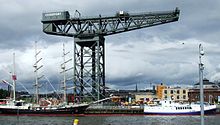
The Finnieston Crane or Stobcross Crane is a disused giant cantilever crane in the centre of Glasgow, Scotland. It is no longer operational, but is retained as a symbol of the city's engineering heritage. The crane was used for loading cargo, in particular steam locomotives, onto ships to be exported around the world.
It is one of four such cranes on the River Clyde, a fifth one having been demolished in 2007, and one of only eleven giant cantilever cranes remaining worldwide. (Full article...)
}
'"`UNIQ--templatestyles-000000DB-QINU`"'
'"`UNIQ--references-000000DC-QINU`"'
Source: (Full article...)
'"`UNIQ--templatestyles-000000DB-QINU`"'
'"`UNIQ--references-000000DC-QINU`"'
Source: (Full article...)
Glass Swords is the debut studio album by Scottish producer Russell Whyte under his alias of Rustie, released by Warp in 2011. The album was produced and recorded between 2008 and 2010 by Whyte, partially in his father's home in Glasgow, Scotland and partly in his own home in London, England. The album contains vocal work from Whyte as well as London based producer Nightwave.
Glass Swords is a musically diverse album that critics found hard to classify as anything specific other than electronic music. The track "Ultra Thizz" was released as a single in September 2011 before the album's release in October of the same year. Re-worked versions of the songs "Surph" and "After Light" were released as singles in 2012 with new vocalists. The album received critical acclaim and was listed as one of the best albums of 2011 by The Guardian, The Wire and Mixmag and shortlisted for the Scottish Album of the Year Award in 2012. (Full article...)
Glass Swords is a musically diverse album that critics found hard to classify as anything specific other than electronic music. The track "Ultra Thizz" was released as a single in September 2011 before the album's release in October of the same year. Re-worked versions of the songs "Surph" and "After Light" were released as singles in 2012 with new vocalists. The album received critical acclaim and was listed as one of the best albums of 2011 by The Guardian, The Wire and Mixmag and shortlisted for the Scottish Album of the Year Award in 2012. (Full article...)
The 1966 European Cup Winners' Cup final was an association football match between Borussia Dortmund of West Germany and Liverpool of England played on 5 May 1966 at Hampden Park, Glasgow, Scotland. It was the final match of the 1965–66 season of Europe's secondary cup competition, the European Cup Winners' Cup. Both sides were competing in their first European final.
Each club needed to progress through four rounds to reach the final. The rounds were contested over two legs, with a match at each team's home ground. Borussia's ties varied from close affairs to comfortable victories. They beat Atlético Madrid by a single goal over two legs, while they defeated Floriana 13–1 on aggregate in the first round. Liverpool's ties were mainly close affairs. Only one of Liverpool's ties was won by more than two goals. (Full article...)
Each club needed to progress through four rounds to reach the final. The rounds were contested over two legs, with a match at each team's home ground. Borussia's ties varied from close affairs to comfortable victories. They beat Atlético Madrid by a single goal over two legs, while they defeated Floriana 13–1 on aggregate in the first round. Liverpool's ties were mainly close affairs. Only one of Liverpool's ties was won by more than two goals. (Full article...)
Edinburgh Castle is a historic castle in Edinburgh, Scotland. It stands on Castle Rock, which has been occupied by humans since at least the Iron Age. There has been a royal castle on the rock since at least the reign of Malcolm III in the 11th century, and the castle continued to be a royal residence until 1633. From the 15th century, the castle's residential role declined, and by the 17th century it was principally used as a military garrison. Its importance as a part of Scotland's national heritage was recognised increasingly from the early 19th century onwards, and various restoration programmes have been carried out over the past century and a half.
Edinburgh Castle has played a prominent role in Scottish history, and has served variously as a royal residence, an arsenal, a treasury, a national archive, a mint, a prison, a military fortress, and the home of the Honours of Scotland - the Scottish regalia. As one of the most important strongholds in the Kingdom of Scotland, the castle was involved in many historical conflicts from the Wars of Scottish Independence in the 14th century to the Jacobite rising of 1745. Research undertaken in 2014 identified 26 sieges in its 1,100-year history, giving it a claim to having been "the most besieged place in Great Britain and one of the most attacked in the world". Few of the present buildings pre-date the Lang Siege of 1573, when the medieval defences were largely destroyed by artillery bombardment. The most notable exceptions are St Margaret's Chapel from the early 12th century, which is regarded as the oldest building in Edinburgh, the Royal Palace, and the early 16th-century Great Hall. The castle is the site of the Scottish National War Memorial and the National War Museum. The British Army is still responsible for some parts of the castle, although its presence is now largely ceremonial and administrative. The castle is the regimental headquarters of the Royal Regiment of Scotland and the Royal Scots Dragoon Guards and houses their regimental museums, along with that of the Royal Scots. (Full article...)
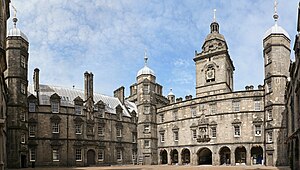
Architecture in early modern Scotland encompasses all building within the borders of the kingdom of Scotland, from the early sixteenth century to the mid-eighteenth century. The time period roughly corresponds to the early modern era in Europe, beginning with the Renaissance and Reformation and ending with the start of the Enlightenment and Industrialisation.
Vernacular architecture made use of local materials such as stone, turf and, where available, wood. Most of the population was housed in small hamlets and isolated dwellings. The most common form of dwelling throughout Scotland was the long house, shared by humans and animals. About ten percent of the population lived in the burghs, in a mixture of half-timbered and stone houses. (Full article...)
McEwan's is a brand of beer owned by Carlsberg Marston's Brewing Company. It was originally brewed by William McEwan's Fountain Brewery in Edinburgh, Scotland. The McEwan's brand passed to Heineken in 2008 after their purchase of Scottish & Newcastle's British operations. Heineken sold the brand to Wells & Young's in 2011, who sold their brewing operation, including the McEwan brand to Marston's in 2017. Cans and bottles are now brewed in Bedford, England. (Full article...)
Krysty Norma Lesley Wilson-Cairns (born 26 May 1987) is a Scottish screenwriter. Born and raised in Glasgow, she studied at the Royal Conservatoire of Scotland and the National Film and Television School. During her teenage years, she was a runner on television series including the detective show Taggart. Her script for the unproduced science fiction thriller Aether made the 2014 Black List and led to a staff writer role on the television show Penny Dreadful. Her feature film debut was the screenplay for the Sam Mendes-directed 2019 war film 1917. She co-wrote it with Mendes and received nominations for the Academy Award for Best Original Screenplay and the Writers Guild of America Award for Best Original Screenplay. (Full article...)





